Completing the Monster Manual:
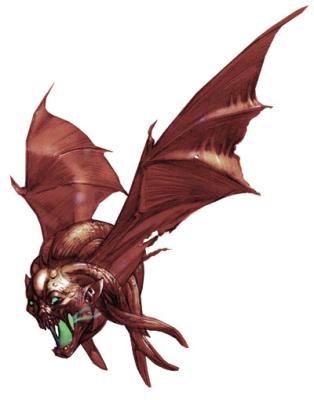
The Vargouille is a creature from before there were different creature types in D&D and eded up as an outsider in 3rd edition, even though it could just as well have been made undead like the bodak. As far as I am aware, they first appeared in the Planescape setting and they are a wonderful example of how the setting is full of things that are simultaneously silly, cool, and somewhat creepy. A vargouille is a humanoid head with a large pair of wings that has a terrifying scream that makes any creatures within 20 meters become paralyzed by fear. Their bite does very little damage, but also has a poison that makes it impossible for the target to heal any kind of injuries. But most terrifyingly, a vargouile can fly up to a paralyzed victim and give it a kiss, which starts a slow process of transformation that first makes the hair fall out, then the ears turn into large bat wings, makes it go insane, and finally causes the head to ripp off the neck and fly away as a new vargouille. Funny. But as always, some more description what you’re supposed to do with it would have been nice.
The Wight really is just a very beefed up ghoul. I like this monster and when you go into the details its background and context makes it a quite different creature. It’s still a starved corpse that sneaks around in the dark. (Variant Ghoul +1)
The Winter Wolf is a huge white wolf with who can breath icy cold and whose bite deals cold damage. Just like a color flipped hellhound. It’s bigger and tougher though, and also of human intelligence and with the ability to talk. They are not exactly masterminds, but are smart and dangerous enough to be villains in their own right who command weaker creratures as their minions. (Demon Dog +1)
And of course the Worg, because Tolkien did it. And everything that Tolkien did has to be in D&D! Its a big wolf that is slighly intelligent and evil. (Demon Dog +1)
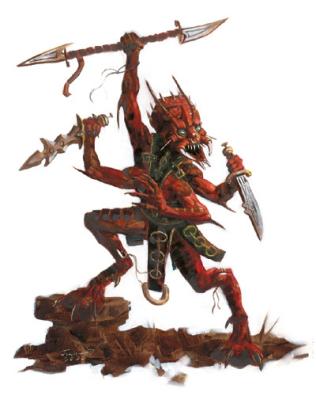
Xills are creatures that come from the novel Voyage of the Space Beagle, which also got us the displacer beast. It’s a four armed, demonic looking humanoid, but it’s actually from the ethereal plane. Unlike most ethereal monsters, it takes a xill significantly longer to move between the ethereal and material world, which makes impossible to quickly blink in and out and avoid any retaliation by its enemies. They are very intelligent and also evil, and as a nice thouch we’re also told that groups are often led into battle by a cleric of a deity of strength and travel. Their four arms help them with wrestling their enemies and when they can get a hold, they use their poisonous bite that can paralyze for several hours. The saving throw to resist it is not too high and there’s a good chance to withstand the poison, but then the xill can just try again the next round until it works. Unlike other monster (foreshadowing!) their ability to grapple is not excessively high and they can not try to bite without grappling an enemy first, which makes the ability not too powerful, but still something that can add a nice touch to a fight. Especially when the xills want to take prisoners, which they do to implant their eggs into them. With a duration of 90 days until the eggs hatch, there is plenty of time to try to rescue those prisoners and get them help. If you make some more backstory and context for them, these could be quite interesting enemies for a campaign.
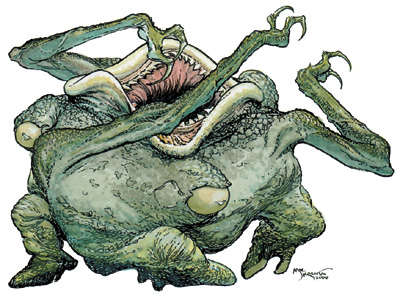
The Xorn is a very old enemy that goes back at least to AD&D 1st edition. It is also one of my least favorite ones. However, I really have to give it to the person who came up with it that it is an interesting approach to how a creature might look like that is native to a world that is almost entirely solid earth and rock in all direction to infinite, with no Up or Down dictated by gravity. It just has a front, where the huge mouth is located, and a back, where it has its feet. Like the delver, it is intelligent, has neutral alignment, and loves to eat metal. And it doesn’t have too much reservations about eating the metal that other people are carrying. Being a creature of the Elemental Plane of Earth, it doesn’t have to dig through the ground, but can just move through it as if it was immaterial. It’s actually not that bad, except that you get a bit of a problem when you have it jump at people to steal their valuables and still being neutral, but that is more a fault of alignment than the creature. If you ignore alignment (like everyone should), it’s really not bad.
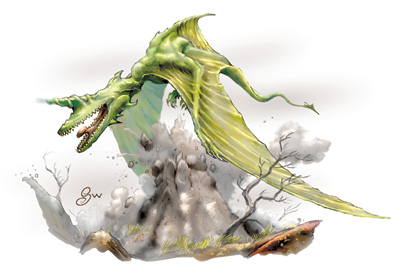
The Yrthak is one of the monster completely new to this book. It is a huge flying reptile with a wingspan of 12 meters, that may resemble a wyvern or dragon at a first glance, but has a noticable lack of any kind of eyes. Instead they sense their surroundings by echolocation by bats. While this kind of perception detects everything that is mostly solid regardless of light or the presence of illusions, this ability only has a range of 40 meters, which for a flying beast of this size really isn’t much, so it’s quite easy to just pass by without spotting the players. I would assume it can sense a general outline of the terrain beyond that distance, or it would be extremely dangerous to fly around in the mountains. In addition to its bite and claws, an yrthak can produce very powerful shockwaves from the horn on its head, which it can direct at a single nearby creature to cause considerable damage that completely ignores armor. Alternatively, it can aim the blast at stone walls, large boulders, or rocky ground to make it explode in a burst of stone shards that injure anyone within 3 meters of the impact. Even though yrthaks don’t speak, they are still quite intelligent creatures like wyverns or worgs. It seems to me that an yrthak, or multiple ones, probably work best when you prepare a special battlefield specifically for the encounter. Just in the middle of a green field wouldn’t be very interesting, you need something with lots of opportunities for the players to hide and things that the yrthak could blast to pieces. Designing such a battlefield would require some real work though, and the book doesn’t give any advice in this regard.
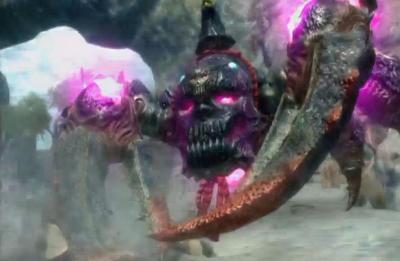
Bonus Monster: That Damn Crab! This creature is not from the Monster Manual but was released on the WotC website many years later together with two other creatures for an aquatic campaign. And it probably is the worst creature published for D&D ever! It is also a good example how the assumption that Challenge Ratings and Encounter Levels in 3rd edition are in any way objective or even reliable measures to determine how strong a creature is and what makes a good fight for a given group of characters. So this giant enemy crab is listed with a CR of 3, which really is where all of the insanity and terribleness of this monster comes from. The Monstrous Crab looks very plain and ordinary at first glance. Large Vermin with 7 hit dice and the Improved Grab and Constrict abilities, which you would expect from any 3rd edition monster with huge claws, tentacles, or even just a snake tail. It also has a Strength score of 22, which doesn’t seem too outrageous, but it becomes when you add it all together. It makes attacks with a +10 bonus to attack rolls and deals 1d8+9 points of damage. That’s quite nasty, but the giant crocodile is CR 4 and does a good deal more damage and the CR 4 polar bear has a significantly better chance to hit. So that seems pretty reasonable so far. But then we get to grappling and things get crazy. Someone thought it would be a good idea to make the Damn Crab! even better at grappling than a normal creature of its size and strength, and created the new Powerful Claws ability, which adds another +4 to grapple and increases the damage bonus from Strength 22 by another 50%. And so this thing has a grapple bonus of +19. Assuming a 3rd level fighter with 16 Strength, he would have a grapple bonus of +6. Most other 3rd level characters would be just +3 or +4. 1d20+19 versus 1d20+4 is no contest. This thing will win almost every grapple check. Unless my statistics are failing me, over 97% of the time against a character with a bonus of +4. That’s already bad. But here Constrict and Improved Grapple come into play. When the Monstrous Crab hits with an attack (with +10 the chances are good), it automatically also makes a free grapple attempt, which it will of course win. And then it also deals damage again, because of the Constrict ability. Which means if you get hit by a claw, it will crush you for massive damage of 2d8+18 (20-34) points. An unarmed 3rd level fighter might have 34 hit points. But most 3rd level characters would be happy to have even 20. If you’re not dead yet, in the next round the Damn Crab! only has to make another grapple check (which it will win) to deal another 10-17 damage and most characters will be dead by then. With an armor class of 19 and 66 hit points, you need some seriously optimized frontline PCs to take this thing out in the first round. Because if they don’t, it will just pick them up in its claw, and to do anything against a monster that grapples you, you need to win a grapple check against it. Which you won’t. It’s not that this thing is completely terribly written. It actually works, just not as a good fight against 3rd level characters. Some people who know the math of D&D better than the people who made the game have calculated that it’s strength is more comparable to monsters with a CR of 7 or 8.
Monster Manual Cliche Creature Counter:
- Evil Apes: 1
- Variant Ghouls: 1
- Demon Dogs: 5
- Skeletons with Robes: 0
Fantasy Safari Score:
- Evil Apes: 18
- Variant Ghouls: 16
- Demon Dogs: 15
- Skeletons with Robes: 9
